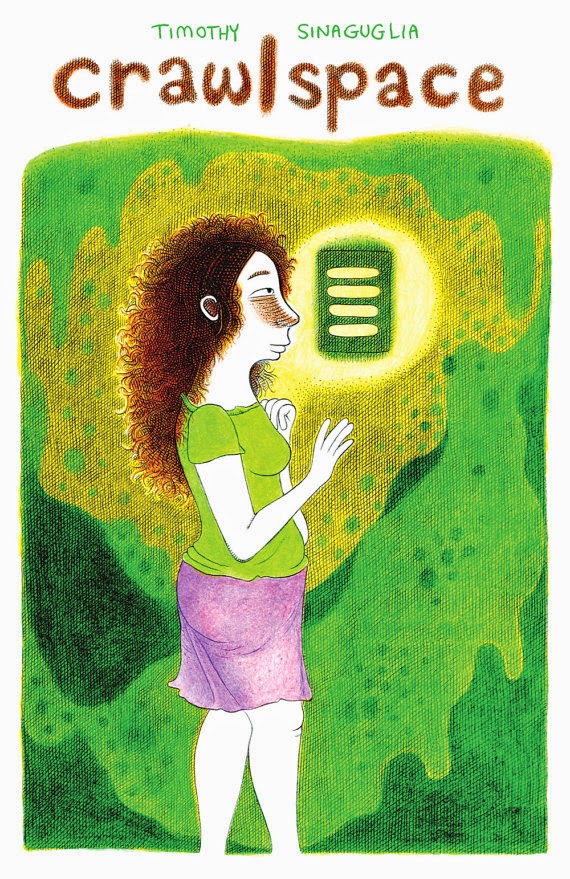Let's take a look at the fledgling publisher So What? Press and some recent releases.
7 or 8, by Lara Antal. This autobio comic about a failed job interview was later fictionalized in Antal's Night Watchman comic. It's about turns of bad luck, the feeling of being stuck in a dead-end job and the sheer weirdness that life presents us with sometimes. Antal's line is a mix between naturalism (especially in close-ups on faces) and cartoony exaggeration, like when she starts to get rained on and her shoulders slump dramatically or when she cringes in horror when she first meets a potential new employer. This is a short comic that's less about specific events and more about the feelings the author has about her station in life.
Tales of the Night Watchman #3, by Dave Kelly, Lara Antal and Amanda Scurti. From the very beginning, Kelly has written stories for artists other than co-creator Antal for this supernatural slice-of-life series. It's been a bit of a risky proposition, because not every artist has been a great fit. Take Scurti in "The Dwellers of Big Bogie", for example. The story idea, of a creepy supernatural creature luring children down to the sewers, is solid enough. However, Scurti's character work is badly in need of someone else's inking, because the faces are too sketchy and indistinct. It would have worked fine if this comic was in color, but the greyscaling combined with her often too-light line widths made faces disappear into the page at times. Antal is actually less skilled as an artist than Scurti, but her thick line and slightly clumsy way she stages her characters simply fits this group of weirdo characters much better. Each one of the main three characters is trying to figure out their life. Street kid Serena doesn't understand what an opportunity she's been given, and it's obvious that life will have to inflict a few more lessons before she does. Charlie, the titular Night Watchman, is a dead man trying to regain his memories while protecting New York from various supernatural menaces. Nora, the barista and manager of a coffee shop, is trying to get a job that befits her actual skill set as a journalist, with no success. This installment is mostly just set-up, character building and laying down some future plot points in a rambling, charming manner. This is a genre comic I can get behind.
Crawlspace, by Timothy Sinaguglia. So What? has proven to be highly unpredictable as to what sort of comics they publish. Crawlspace almost feels like a Domino book (complete with a blurb from publisher Austin English on the back), as Sinaguglia's eccentric storytelling style is given free reign in these two stories. The first, "She Smiled Back" is a fascinating account of adolescent sexual awakening paired with a new awareness of sexual identity. It follows a teen boy trying to figure out sex getting the idea to try on women's clothing and stare at himself for hours. It's remarkably honest and almost pure in how it distills this dawning self awareness. Visually, Sinaguglia goes heavy on hatching, especially with regard to noses. The hatching indicates the artist's fascination with creating both ugly and worked-over images and contrasting them with beauty. The second story, Trudy, is far more elliptical, as it follows a girl venturing outside for an unusual walk, dealing with elements that are vaguely threatening yet not unsettling to her. It's as though the female persona of the first story went out for a walk on her own, always aware that she was a double of someone else. There's something aching about Sinaguglia's comics; they are not sad, per se, but there's a sense of yearning and incompletion that haunts each beautiful page.
City Chickens, by Jess Ruliffson. One story at a time, Ruliffson is telling the stories that belong to a city and its frequently bruised and traumatized residents. This story is a bit more upbeat than some of her other comics, detailing the specifics of how to raise chickens at a particular community garden in Brooklyn. Born out of the wreckage of old properties, it provides a vital green space for its residents, a space where life grows amidst concrete and steel. Ruliffson's line is lively and expressive while still focusing on the matter at hand: a naturalistic depiction of her subjects for documentarian purposes. By sticking to a narrow question (how, when and why to raise chickens in the city), she helps focus her narrative while allowing herself to veer off a bit here and there to provide context and depth. I like that Ruliffson is honing her chops on these small stories, but I'd say she's ready for a bigger assignment.
Subscribe to:
Post Comments (Atom)








No comments:
Post a Comment